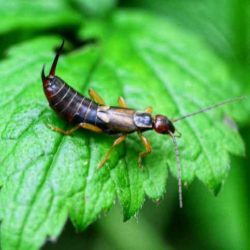Earwig Garden Pest Removal
If you’ve seen an earwig, you may think they look like an intimidating insect that could cause you harm. But that’s not the case. In this guide, we’ll look at how to identify earwigs and, more importantly, how to get rid of them if they’re making themselves at home.
What Is an Earwig?
An earwig is an insect with two antennae, six legs, three body parts, and a formidable set of pincers on the end of its abdomen. It ranges from 5 to 25 millimeters in size, depending on the species. And, though it is possible to find an earwig in your ear, they do not lay their eggs in the ear canals of humans, nor do they feed on brains, as myth may have you believe. For the most part, earwigs are considered harmless to humans. They can, however, make for a frustrating pest when they get into gardens, flower beds, and homes. In addition:
- There are more than 1,000 documented species of earwig in the world and 22 types in the United States.
- Earwigs like to live in large numbers. Scientists believe that they group together because of a pheromone scent released by these insects.
- Some earwigs have wings, and some do not. In either case, they rarely fly.
- Earwigs are mostly nocturnal. They hide in cool, moist places during the day and come out at night to feed.
Where Do Earwigs Live?
Earwigs love moisture and humidity, which means two things: Outside, you’ll find them under piles of wet leaves, lawn clippings, and mulch. In addition, you may see them on lawn chairs—especially after recent rain. If they get into your home, they’ll move through the whole structure. Earwigs tend to gravitate to crawl spaces under your home and absolutely love bathrooms. If you have a basement that tends to get damp or humid, you may also find earwigs there.
What Do Earwigs Eat?
Most earwigs are omnivores that eat just about anything, including other insects and plants. Earwigs love to munch on leaves, fruits, vegetable plants, flowers, insects, and mold. In fact, if parts of your home—inside or out—have rotting wood due to excess moisture, you have an environment ripe for earwig infestation.
Are Earwigs a Threat?
Earwigs don’t bite, but they can pinch, although it isn’t painful. They don’t spread bacteria or disease, and they have no venom. The biggest problem with earwigs is that they are a nuisance pest, entering your home through cracks and gaps in foundation walls, pipes, and window frames. If they prefer vegetation, they can cause problems for gardeners.
Do They Have Any Benefits?
Because earwigs are omnivores, they can provide some garden benefits by eating aphids, mites, or other pests. They can also be considered a sign of moisture damage, so if you see them in your home, it’s worth a closer inspection to find and fix the damage before it gets worse.
Pest Control for Earwigs
If you see earwigs in your home or garden (and don’t want them there), you do have a few options for preventing them. Keeping your yard raked and cleaned up will go a long way to reducing the earwig population around your lawn. Reducing foliage or tree coverage in some areas around your home can make lawn cleanup faster and reduce the amount of drying time after rain. Additionally, you can:
- Clean up rotting wood on or around your property
- Keep shrubs and plants trimmed around the foundation to reduce daytime hiding places
- Reduce or eliminate flower bed lighting or other lights around your home
- Use caulk or liquid cement to fill holes, gaps, or cracks in your foundation or exterior walls
- Call a trusted pest control company for routine service on your property
Call McCall Pest & Wildlife for Extra Help
Earwigs aren’t dangerous, and they aren’t particularly damaging, but they can be a major nuisance around the home. If you need help dealing with a sudden invasion of earwigs—or any insect pest—let McCall Pest & Wildlife help. Our comprehensive pest control plans work to make your home unwelcome to pests and more enjoyable for you and your family. Contact us today to schedule your inspection.


